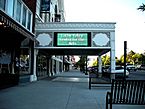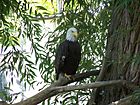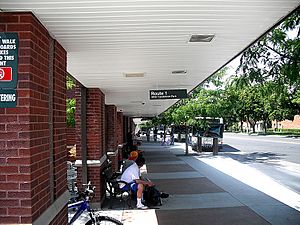Logan, Utah facts for kids
Quick facts for kids
Logan, Utah
|
|
|---|---|
|
City
|
|
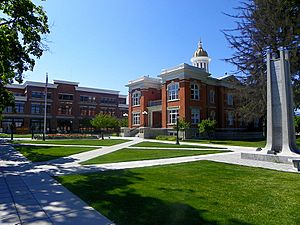
Downtown Logan, with courthouse
|
|
| Motto(s):
"United in Service"
|
|
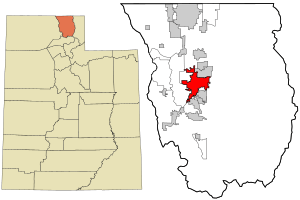
Location in Cache County and the state of Utah
|
|
| Country | United States |
| State | Utah |
| County | Cache |
| Founded | 1859 |
| Incorporated | January 17, 1866 |
| Named for | Ephraim Logan |
| Government | |
| • Type | Mayor-council |
| Area | |
| • Total | 18.43 sq mi (47.74 km2) |
| • Land | 17.84 sq mi (46.22 km2) |
| • Water | 0.59 sq mi (1.52 km2) |
| Elevation | 4,534 ft (1,382 m) |
| Population
(2020)
|
|
| • Total | 52,778 |
| • Density | 2,957.5/sq mi (1,141.89/km2) |
| Time zone | UTC−7 (Mountain (MST)) |
| • Summer (DST) | UTC−6 (MDT) |
| ZIP Codes |
84321-84323, 84341
|
| Area code | 435 |
| FIPS code | 49-45860 |
| GNIS ID | 1442849 |
Logan is a city in Cache County, Utah, United States. The 2020 census recorded the population was 52,778. By 2050 the population of Logan is expected to double. Logan is the county seat of Cache County and the principal city of the Logan metropolitan area, which includes Cache County and Franklin County, Idaho. The Logan metropolitan area contained 125,442 people as of the 2010 census and was declared by Morgan Quitno in 2005 and 2007 to be the safest in the United States in those years. Logan also is the location of the main campus of Utah State University.
Contents
History
The town of Logan was founded in 1859 by settlers sent by Brigham Young to survey for the site of a fort near the banks of the Logan River. They named their new community "Logan" for Ephraim Logan, an early fur trapper in the area. Logan was incorporated on 17 January 1866. Brigham Young College was founded here in 1878 (but later closed), and Utah State University – then called the Agricultural College of Utah – was founded in 1888.
Logan's growth reflects settlement and post-war booms along with other changes incident to conditions in the West. Logan grew to about 20,000 in the mid-1960s, and according to Census estimates, exceeded 50,000 in 2015.
Geography and climate
Logan is located in northern Utah, 47 miles (76 km) north of Ogden, on the Logan River. It is about 82 miles (132 km) north of Salt Lake City.
According to the United States Census Bureau, the city has a total area of 18.5 square miles (48.0 km2), of which 18.0 square miles (46.5 km2) is land and 0.58 square miles (1.5 km2), or 3.16%, is water.
The city lies near the eastern edge of Cache Valley on the western slopes of the Bear River Mountains, the northernmost branch of the Wasatch Range. Mount Logan rises to an elevation of 9,710 feet (2,960 m) immediately to the east, and south of Logan Canyon. The eastern portions of the city are constructed on top of shelf-like "benches", late Pleistocene sedimentary deposits that were created by the glacially fed Logan River feeding into the northern stretches of Lake Bonneville, building a "Gilbert-type" river delta over several thousand years. The Logan River later cut down through these sedimentary deposits following the draining of Lake Bonneville approximately 14,500 years ago. This created a low-lying area with very steep slopes that reach into the rest of town and to the Logan River bottomlands. To the west of Logan lie flatlands that contain both farmland and marshes. To the north and south of Logan are rapidly growing residential suburbs.
Logan has a humid continental climate (Köppen Dfa/Dfb) with very warm though usually dry summers and cold winters with moderate snowfall. Precipitation tends to be heaviest in the spring months. Similar to other areas in northern Utah, during mid-winter high pressure systems often situate themselves over Cache Valley, leading to strong temperature inversions. These temperature inversions trap cold air and pollutants and allow thick smog to accumulate in the valley about three percent of the time. This can result in the worst air-pollution levels in the U.S., reducing air quality to unhealthy level.
| Climate data for Logan, Utah | |||||||||||||
|---|---|---|---|---|---|---|---|---|---|---|---|---|---|
| Month | Jan | Feb | Mar | Apr | May | Jun | Jul | Aug | Sep | Oct | Nov | Dec | Year |
| Record high °F (°C) | 60 (16) |
67 (19) |
74 (23) |
84 (29) |
92 (33) |
99 (37) |
104 (40) |
102 (39) |
99 (37) |
86 (30) |
71 (22) |
67 (19) |
104 (40) |
| Average high °F (°C) | 30.9 (−0.6) |
36.8 (2.7) |
48.6 (9.2) |
58.6 (14.8) |
68.2 (20.1) |
79.0 (26.1) |
88.3 (31.3) |
87.1 (30.6) |
76.2 (24.6) |
63.1 (17.3) |
45.4 (7.4) |
33.3 (0.7) |
59.6 (15.3) |
| Average low °F (°C) | 12.7 (−10.7) |
16.8 (−8.4) |
26.5 (−3.1) |
33.8 (1.0) |
41.8 (5.4) |
48.6 (9.2) |
54.9 (12.7) |
53.4 (11.9) |
44.2 (6.8) |
33.5 (0.8) |
24.2 (−4.3) |
14.4 (−9.8) |
33.7 (0.9) |
| Record low °F (°C) | −25 (−32) |
−29 (−34) |
−12 (−24) |
10 (−12) |
20 (−7) |
29 (−2) |
39 (4) |
34 (1) |
22 (−6) |
6 (−14) |
−10 (−23) |
−30 (−34) |
−30 (−34) |
| Average precipitation inches (mm) | 1.34 (34) |
1.42 (36) |
1.86 (47) |
1.98 (50) |
2.11 (54) |
1.26 (32) |
0.89 (23) |
0.93 (24) |
1.55 (39) |
1.78 (45) |
1.38 (35) |
1.36 (35) |
17.86 (454) |
| Average snowfall inches (cm) | 9.2 (23) |
6.9 (18) |
3.9 (9.9) |
1.4 (3.6) |
0 (0) |
0 (0) |
0 (0) |
0 (0) |
0 (0) |
0.4 (1.0) |
2.1 (5.3) |
5.7 (14) |
29.6 (74.8) |
| Average precipitation days (≥ 0.01 inch) | 9.9 | 9.3 | 9.7 | 10.0 | 10.5 | 5.9 | 5.0 | 4.8 | 6.2 | 7.0 | 9.0 | 9.1 | 96.4 |
| Average snowy days (≥ 0.1 inch) | 5.0 | 2.9 | 1.8 | 0.8 | 0 | 0 | 0 | 0 | 0 | 0.4 | 1.5 | 4.0 | 16.4 |
| Source: NOAA | |||||||||||||
Layout
Logan's city grid originates from its Main and Center Street block, with Main Street running north and south, and Center east and west. Each block north, east, south, or west of the origin accumulates in additions of 100 (e.g. 100 North, 100 East), though some streets have non-numeric names. This street grid is typical of many towns and cities that were founded by Latter-day Saints in the Mormon Corridor. Most of Logan's commercial businesses are located along Main Street, which spans the entire city.
Logan's downtown area is located in the center of the city and is noted for its many historic buildings and landmarks. Among them are the Logan Tabernacle and Logan Utah Temple, which was constructed on the highest hill in the valley so as to be seen for miles in all directions. Both buildings are owned and operated by the LDS Church. Along Center Street, which intersects Logan's Historic District, are a number of stately houses on the National Register of Historic Places. The downtown area also houses retail and cultural outlets, as well as the municipal and county buildings and courthouses.
The eastern portion of Logan includes the Cliffside and Island neighborhoods, as well as the University district. Utah State University (USU), with its many educational, cultural, agricultural, and athletic programs, was established in 1888. The campus stands on the eastern side of the city, near to the mountains. USU is the city's largest employer, and it has an enrollment of about 17,000 students in Logan. Logan Canyon begins in the foothills close to campus.
Logan's southern portion is a mixture of commercial and residential, and contains portions of the Logan River as well as the fairgrounds and aquatic center. The northern area of Logan serves partly as a retail district with numerous shops and restaurants, including the Cache Valley Mall. Logan has the region's largest and most comprehensive hospital, Logan Regional Hospital. The western portion of Logan is set aside as a center for light industry, especially along the area of 1000 West Street, and it also contains residential communities.
Demographics
| Historical population | |||
|---|---|---|---|
| Census | Pop. | %± | |
| 1870 | 1,757 | — | |
| 1880 | 3,396 | 93.3% | |
| 1890 | 4,565 | 34.4% | |
| 1900 | 5,451 | 19.4% | |
| 1910 | 7,522 | 38.0% | |
| 1920 | 9,439 | 25.5% | |
| 1930 | 9,979 | 5.7% | |
| 1940 | 11,868 | 18.9% | |
| 1950 | 16,832 | 41.8% | |
| 1960 | 18,731 | 11.3% | |
| 1970 | 22,333 | 19.2% | |
| 1980 | 26,844 | 20.2% | |
| 1990 | 32,762 | 22.0% | |
| 2000 | 42,670 | 30.2% | |
| 2010 | 48,174 | 12.9% | |
| 2020 | 52,778 | 9.6% | |
| source: | |||
People
During the 2020 census, there were 52,778 people. The population was counted at 48,174 in the 2010 census. The racial makeup of the city in 2010 was 83.90% White, 1.0% African American, 1.0% Native American, 3.30% Asian, 0.5% Pacific Islander, 8.0% from other races, and 2.3% from two or more races. Hispanic or Latino of any race were 13.9% of the population.
Age
As of the 2000 Census there were 13,902 households counted in Logan, out of which 33.4% had children under the age of 18 living with them, 55.1% were married couples living together, 7.7% had a female householder with no husband present, and 34.0% were non-families. 17.9% of all households were made up of individuals, and 5.7% had someone living alone who was 65 years of age or older. The average household size was 2.92 and the average family size was 3.20.
In the city, the population was spread out, with
- 23.4% under the age of 18
- 34.3% from 18 to 24
- 25.5% from 25 to 44
- 9.7% from 45 to 64
- 7.1% who were 65 years of age or older.
The median age was 24 years. For every 100 females, there were 92.1 males. For every 100 females age 18 and over, there were 89.5 males.
Income
As of the 2000 Census the median income for a household in the city was $30,778, and the median income for a family was $33,784. Males had a median income of $27,304 versus $19,687 for females. The per capita income for the city was $13,765. About 12.6% of families and 22.7% of the population were below the poverty line, including 15.6% of those under age 18 and 6.4% of those age 65 or over.
Arts and culture
Logan is home to the Utah Festival Opera, which hosts a number of performances through the year. The Ellen Eccles Theatre shows concerts, community theater, ballet, and classic movies, and it also hosts national touring companies. Cache Valley Center for the Arts offers a variety of community arts classes and hosts numerous "Gallery Walk" events throughout the year in which participating businesses in historic downtown Logan feature different art, music, and food. The Summerfest Arts Faire, held annually at the Logan Tabernacle grounds on Father's Day Weekend, celebrates the arts through a fine art/fine craft festival with music, food and children's activities.
Utah State University hosts many artistic and cultural events, including traveling art galleries, symphony performances, plays and public lectures.
Logan Library, founded in 1916, makes more than 200,000 items available for residents to borrow and also hosts hundreds of events each year for all ages.
Logan hosts a vendor owned farmers' market every Saturday from May thru October. Named one of America's best farmers' markets in 2009, the "Cache Valley Gardeners' Market" was located at Merlin Olsen Park, and is now located in front of City Hall. Over twenty years old, the market is known as a gathering place for the sale of fresh, local produce, coffee, artisan breads, eggs, homecrafted gift items, art, children's activities and also for weekly concerts.
In 2009, Logan ranked No. 10 on Newsmax magazine's list of the "Top 25 Most Uniquely American Cities and Towns," a piece written by current CBS News travel editor Peter Greenberg. In determining his ranking, Greenberg cited the popular Utah Festival Opera.
Parks and recreation
Logan's Parks and Recreation department runs the Logan River Golf Course, the Logan/Cache County Fairgrounds, and the Logan Aquatic Center.
Logan Canyon has numerous hiking and camping areas, and its scenic First, Second, and Third Dams provide popular gathering spots for picnics and fishing. Tony Grove Lake is located 25 miles to the east, at an elevation of 8,050 feet, with fishing, canoeing, camping and high-elevation hiking. Logan Canyon also offers rock-climbing, snowmobiling, hunting and skiing.
The Willow Park Zoo is a small zoo in Logan's Willow Park, with a small collection of wild animals including monkeys, coyotes, bobcats, bald eagles, and land birds and ducks.
Logan is the home of two full-length golf courses, the Logan River Golf Course and the Logan Golf and Country Club. Other golf courses are also found around the Cache Valley Area.
There are numerous events at the Logan/Cache County Fairgrounds including fairs, rodeos, and demolition derbies. Nearby, the city of Logan runs an aquatic center and a skate park. During the winter season, the city operates an outdoor ice skating rink at Merlin Olsen Park (Central Park).
Transportation
In 2009, the Logan metropolitan statistical area (MSA) ranked as the eighth highest in the United States for percentage of commuters who biked to work (3.3 percent).
Highways
U.S. Highways US-89 and US-91 enter Logan from the southwest as a combined highway, and then separate in downtown Logan. US-91 goes north into Idaho, and US-89 goes east into Logan Canyon, and thence to Bear Lake. The Logan Utah-Idaho Metropolitan Statistical Area is one of the few metropolitan statistical areas in Utah not connected via an interstate highway (Interstate 15), and one of the few its size not connected to any interstate anywhere.
Transit and taxi
Logan is served by a local sales-tax-funded zero-fare bus system called the Cache Valley Transit District (CVTD), which incorporated the Logan Transit District (LTD) in 2007. The LTD system began in 1992 with six routes in Logan. Service outside of Logan began with the formation of CVTD in 2001. The system has 16 routes that serve Logan and the adjacent cities of North Logan and River Heights. These include a northern route that reaches north to Richmond, and a southern route that serves the southern suburbs and Hyrum. There is also a five-time daily connection to Lewiston and Preston, Idaho. Despite a shorter distance to, and a larger resident population, there remains no connection with Brigham City within the CVTD; some have speculated this is due to pressure from the For-Profit shuttle, Salt Lake Express, operating within Cache Valley.
There are also two taxi companies, Cache Cab LLC and Logan Taxi.
Air travel
There is a public general aviation airport at Logan, the Logan-Cache Airport (with IATA code LGU), but has no scheduled airline services. However, Logan is within ready driving distance or shuttle ride of Salt Lake City International Airport. The Logan-Cache Airport also offers flight instruction and classes to USU students, along with some scheduled services of private carriers or arrangements.
Special events
Logan hosts the annual "Cache Valley Cruise-In", Utah's largest automotive event, with a three-day exhibit of special cars and vehicles, concerts, and other activities. Events conclude with a car parade on Main Street.
Logan is also home to the annual "Small Satellite Conference", a week long conference attended by industry and academia from around the world, hosted by the American Institute of Aeronautics and Astronautics and Utah State University.
Each July Logan showcases local artwork, food, and performers at its annual Summerfest Arts Faire on the lawn of the historic Logan Tabernacle.
In October 2016 the city held its first annual LGBTQA Pride festival.
Recognition
- CNN Money magazine ranked Logan third on its list of Best Places to Retire Young in 2007.
- In 2006 Forbes listed Logan 10th on its list of Best Small Places For Business & Careers.
- The Monday Report listed Logan as the most walkable community in Utah in a 2009 study.
- In 2010 The Daily Beast ranked Logan the #1 city in America to be a kid on Christmas.
Economy
Logan has a wide diversity of economic sectors with a focus on education, manufacturing and processing, medical services, agriculture, and retail businesses. The city's largest employer is Utah State University, with other major employers including Icon Health & Fitness, Cache County School District, Logan Regional Hospital, Thermo Fisher Scientific, Gossner Foods, and Schreiber Foods.
Headquartered in Logan
- Utah State University – doctoral land-grant university
- Space Dynamics Laboratory - USU owned research corporation
- CVB INC d/b/a Malouf - manufacturer of bedding and furniture products
- ICON Health & Fitness – manufacturer of fitness equipment
- S&S Worldwide – manufacturer of amusement park rides
- Gossner Foods – dairy product manufacturer
- Utah Festival Opera – founded and headquartered in Logan
- Ifrogz - manufacturer of cases for Apple products
- Altra Zero Drop Footwear - running footwear
- Camp Chef - manufacturer of outdoor cooking equipment
- Cache Valley Bank - regional bancorporation
- Electric Power Systems (EP Systems) - manufacturer of electric propulsion systems for transportation markets
- Scytek Laboratories Inc – manufacture of diagnostic reagents Special Stains, Antibodies, Hematology, Microbiology, Hematoxlyn
Other
- Cytiva –bioprocessing products and services
- RR Donnelley – mass printing and manufacturing
- PoliticIt - political website
- Life Technologies - technology for biotech
- Logan River Academy - a residential treatment center for teens
Education

According to the U.S. Census Bureau, 12.3% of adults 25 years and older have graduate or professional degrees, 22.2% have bachelor's degrees, 8.4% have associate degrees, and 27.7% have some college but no degree. This may be an influence of the high percentage of Utah State University faculty and staff residing in the city.
Average ACT scores in the Logan School District in 2005 were 21.5 for English, 21.3 for math, 22.7 for reading, 22.1 for science and 22 composite score. Average ACT scores in the Cache County School District, which surrounds Logan, in 2005 were 20.9 in English, 20.8 in math, 22.5 in reading, 21.5 in science and 21.5 composite score. 250 Logan High students took the ACT in 2005 and 593 Mountain Crest/Sky View/Cache High students (in Cache County School District) took the test in 2005.
Approximately $4,146 is spent per pupil in the Logan School District. In October 2005, there were 2,600 kindergarten through fifth-grade students, 1,252 sixth- through eighth-grade students and 1,702 high school students. Those numbers report about a 100-student decrease from the previous year. Drop-out rate was 2.3%. 11% of students speak English as a second language.
During the 2004–2005 school year there were 321 professional teachers, resulting in a pupil/teacher ratio of 25.9. The average contract salary for teachers was $38,639.
There are six elementary schools (K–5), one middle school, (6–8), and one high school, Logan High School (9–12), with two campuses, in Logan. There is also a charter high school in Logan and one alternative high school in Logan for the Cache County School District. The Cache District has four regular high schools outside Logan in other cities.
Edith Bowen Laboratory School, on the campus of Utah State University, provides an alternative educational opportunity for children.
Thomas Edison Charter School, which has campuses in North Logan and Nibley, is a public school for grades K-8 offering an academic stimulated curriculum. There are also a number of small private schools in Logan.
Logan River Academy is an adolescent residential treatment center that operates in the southern end of Logan.
InTech Collegiate High School is a public charter school at the Innovation Campus of Utah State University, just outside Logan. It offers an early college program and a STEM (science, technology, engineering, and math)-focused curriculum for grades 9–12.
Bridgerland Technical College provides classes in business, dental technology, design and construction, fashion and hospitality, health science, information technology, manufacturing, nutrition and food, public safety, and transportation.
As the home to Utah State University, a Land-Grant University classified by Carnegie Foundation as a Doctoral/Research University Extensive offers bachelor's degrees, master's degrees, and doctoral degrees in several fields.
Logan was home to the Brigham Young College, a college run by The Church of Jesus Christ of Latter-day Saints (LDS Church) from 1878 to 1926. Its library and its papers were given to the Utah State University when it ceased operating.
Notable people
- Jawahir Ahmed, model and beauty pageant winner
- Neil L. Andersen, LDS Church apostle born in Logan
- Rocky Anderson, mayor of Salt Lake City 2000–08
- Michael Ballam, opera singer, founder of Utah Festival Opera Company
- Elaine Bradley, member of Neon Trees rock band
- Clay Brown, former NASCAR driver
- Hugh B. Brown military officer, politician, LDS Church leader
- Reed Budge, Idaho legislator
- Charles Bullen, politician
- Shay Carl, internet celebrity
- Ron Carlson, novelist and short story writer
- Quentin L. Cook, LDS Church apostle
- Chris Cooley, Washington Redskins football player
- Kevin Curtis, NFL football player
- Marriner Eccles, former chairman of the Federal Reserve Bank
- Luke Falk, football player for Washington State University, New York Jets
- Rulon Gardner, 2000 Olympic gold medalist (Greco-Roman wrestling)
- Hal Garner, football player for the Buffalo Bills
- John Gilbert (actor), silent film star
- Morris R. Jeppson, weapons test officer, Enola Gay
- Robert M. Kimmitt, former Deputy Secretary of the Treasury, United States Ambassador to Germany
- Russell Maughan, pioneer aviator, first person to fly across America in a single day
- Joseph M. Newman, film director
- Chase Nielsen, member of Doolittle Raid
- Merlin Olsen, football player for Los Angeles Rams, actor and TV personality
- L. Tom Perry, LDS Church apostle
- Casey Robinson, screenwriter and film producer
- Lenore Romney, former First Lady of Michigan, mother of Mitt Romney
- May Swenson, poet
- Jean Sullivan, actress
- Kip Thorne, astronomer, physicist, 2017 Nobel laureate for the observation of gravitational waves
- John W. Welch, law and religion scholar
- Larry Winborg, illustrator and gallery owner
- Evelyn Wood, speed-reading entrepreneur
Twin towns – sister cities
Logan is twinned with:
|
See also
 In Spanish: Logan (Utah) para niños
In Spanish: Logan (Utah) para niños




